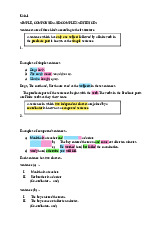


Preview text:
lOMoAR cPSD| 40342981 Reading Passage 1 A survivor's story
One native bird in New Zealand that has managed to survive the introduction of non-native species.
As an island country with a fauna dominated by birds, New Zealand was once home to an
owl species which is now extinct. The laughing owl, named for its distinctive cry. This bird
was widespread throughout the islands when European settlers arrived in the middle of the
19th century and remained in good numbers for some years thereafter. Where other native
birds suffered from predation by the Polynesian rat, the laughing owl turned the tables and
adapted its diet to include the rodent. It was also capable of catching and killing the other
New Zealand owl, the morepork, and even larger birds, such as the weka. However, the
laughing owl was wiped out around the beginning of the 20th century, its demise caused
by specimen collectors, habitat changes, and non-native predators including cats and stoats.
Surprisingly, it is the smaller owl, the morepork, that has managed to survive until this day.
At dusk, the melancholy sound of the morepork can be heard in forests and parks as it calls
to other moreporks and claims territory. Its Maori name, ruru, echoes its two-part cry. In
the tradition of the Maori people of New Zealand, the morepork, or ruru, was often seen as
a careful guardian. A number of sayings referred to the bird's alertness. As a bird of the
night, it was associated with the spirit world. Moreporks were believed to act as messengers
to the gods in the heavens, flying along spiritual paths in the sky. They were the mediums
used to communicate with the gods. The occasional high, piercing call of the morepork
signified bad news, but the lower-pitched and more common ruru call heralded good news.
Speckled dark brown, with yellow eyes and long tails, they are around 20 centimeters long
from head to tail and 175 grams in weight. Moreporks have hinges on the edge of their
feathers, so they can fly almost silently and not alert potential prey. They have acute
hearing and their large eyes are very sensitive to light. Moreporks nest in tree hollows, in
clumps of plants, or in cavities among rocks and roots. In the wild, moreporks usually start
nesting in October, although zoo specimens have been recorded nesting in midwinter,
possibly stimulated by an ample food supply. The female lays up to three white eggs, which
she incubates for 20 to 30 days. During this time, she rarely hunts, and the male brings
food to her. Once the chicks hatch, she stays mainly on the nest until the young owls are
fully feathered. When hatched, chicks are covered in light grey down, and have their eyes
closed. The eyes do not open until the eighth day after hatching. They can fly at around 35 days.
By day, moreporks sleep in crevices. By night, they hunt a variety of animals mainly large
invertebrates including scarab and huhu beetles, moths, caterpillars and spiders. lOMoAR cPSD| 40342981
They also take small birds and mice. They can find suitable food in pine forests as well as
native forest. A morepork will swoop to catch or stun its prey, which it then carries away
in its bill. Moreporks are clever hunters and birds such as robins, grey warblers and fantails
can end up as their prey. In the day, these small birds sometimes mob drowsy moreporks
and chase them away from their roosts. They have a more peaceful life.
The New Zealand Department of Conservation
The New Zealand Department of Conservation is taking steps to ensure the preservation of
New Zealand's only native owl. The department is involved in measuring the population
of moreporks and has put transmitters on a number of birds to determine survival and
mortality. As well as being New Zealand's only native owl, the morepork has symbolic and
spiritual importance, so in monitoring the bird it is hoped that the morepork will continue to survive and thrive.
Other Threats to Moreporks
Predation by non-native predators: Cats, stoats, and ferrets are a major threat to moreporks,
especially nestlings and young owls. Habitat loss: Deforestation and urban development
are reducing the amount of suitable habitat for moreporks. Pesticides: The use of pesticides
can poison prey species, which can then accumulate in the food chain and harm moreporks.
Road mortality: Moreporks are often killed by cars when they fly across roads at night. Conservation Efforts
In addition to the efforts of the New Zealand Department of Conservation, there are a
number of community groups and individuals working to protect moreporks. These efforts
include: Nest box installation: Providing artificial nest boxes for moreporks to breed in.
Predator control: Trapping and poisoning predators to reduce their impact on morepork
populations. Education and awareness: Educating the public about the importance of
moreporks and how to help protect them. By working together, we can help ensure that the
morepork continues to be a part of New Zealand's natural heritage for generations to come. Questions 1-7
Do the following statements agree with the information given in Reading Passage 1?
In boxes 1-7 on your answer sheet, write:
TRUE if the statement agrees with the information FALSE if the statement contradicts the
information NOT GIVEN if there is no information on this
1. Early European settlers made detailed studies of the morepork. lOMoAR cPSD| 40342981
2. The Polynesian rat had a negative effect on the number of laughing owls.
3. The laughing owl was larger than the morepork.
4. Rats pose a risk to young moreporks.
5. The New Zealand Department of Conservation is hoping to limit the population of moreporks.
6. Other bird species are frightened away when they hear the morepork's cry.
7. In Maori tradition, the low call of the morepork had negative associations. Questions 8-13 Complete the notes below.
Choose ONE WORD AND/OR A NUMBER from the passage for each answer.
Write your answers in boxes 8-13 on your answer sheet.
The Morepork Appearance •
approximately 8 ______________in length • large yellow eyes •
feathers with fringes to enable quiet flight Nesting •
nests in trees, plants or spaces in roots and 9 _____________ •
after about 25 days, baby moreporks are capable of leaving the nest Hunting •
transports prey using its 10 _____________ •
can be chased away by other birds during the 11 _____________ •
attacked by 12 _______________that had been introduced to Motuora Island Threats
may be exposed to 13 ______________ in their prey




